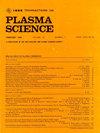Dynamics of Ion-Acoustic Soliton Propagation Near the Super-Critical Values in Relativistic Magnetized Plasmas
IF 1.3
4区 物理与天体物理
Q3 PHYSICS, FLUIDS & PLASMAS
引用次数: 0
Abstract
This article focuses the derivation of a new evolution equation with quartic nonlinearity and its analytical solution along with dynamical features for investigating nonlinear propagation characteristics of ion-acoustic soliton (IAS) in a magnetized, rotating, relativistic plasma environment comprising of relativistic ion fluids and generalized distributed electrons, and positions. Employing the conventional reductive perturbation method, the Korteweg-de Vries (KdV) equation involving quartic nonlinearity is derived. The effect of obliqueness, relativistic streaming factor, rotational frequency, and other related plasma parameters on the nonlinear propagation characteristic is analyzed. The plasma parameters affect remarkably the propagation characteristics of IASs with the consideration of relativistic Lorentz factor (RLF) up to 20 terms rather than 2 or 3 terms. Through the implementation of a traveling wave transformation, a planar dynamical system (PDS) is rigorously formulated. The phase portrait is meticulously constructed, allowing for a comprehensive and deeply nuanced analysis of the emergent nonlinear wave phenomena inherent to the system. It is observed that even the slightest alteration in any parameter can exert a significant and abrupt influence on the propagation dynamics of IASs when approaching the super-critical threshold. The findings presented may contribute to the underlying physics in understanding soliton propagation in the astrophysical scenarios such as magnetosphere, neutron stars, dark matter halos, white dwarfs, etc. in the presence of magnetic field.相对论磁化等离子体中超临界值附近离子-声孤子传播动力学
为了研究离子声孤子(IAS)在由相对论性离子流体和广义分布电子组成的磁化旋转相对论性等离子体环境中的非线性传播特性,本文重点推导了一个新的四次非线性演化方程及其解析解和动力学特征。采用传统的约化微扰方法,导出了含四次非线性的Korteweg-de Vries (KdV)方程。分析了倾角、相对论流因子、旋转频率等相关等离子体参数对非线性传播特性的影响。当考虑相对论洛伦兹因子(RLF)时,等离子体参数对等离子体的传输特性有显著影响,而不是2或3项。通过行波变换的实现,建立了平面动力系统(PDS)的严格公式。相位肖像是精心构建的,允许对系统固有的新兴非线性波动现象进行全面而细致入微的分析。我们观察到,当接近超临界阈值时,任何参数即使是最微小的变化也会对ias的传播动力学产生显著而突然的影响。这些发现可能有助于理解在磁场存在下磁层、中子星、暗物质晕、白矮星等天体物理场景下孤子的传播。
本文章由计算机程序翻译,如有差异,请以英文原文为准。
求助全文
约1分钟内获得全文
求助全文
来源期刊

IEEE Transactions on Plasma Science
物理-物理:流体与等离子体
CiteScore
3.00
自引率
20.00%
发文量
538
审稿时长
3.8 months
期刊介绍:
The scope covers all aspects of the theory and application of plasma science. It includes the following areas: magnetohydrodynamics; thermionics and plasma diodes; basic plasma phenomena; gaseous electronics; microwave/plasma interaction; electron, ion, and plasma sources; space plasmas; intense electron and ion beams; laser-plasma interactions; plasma diagnostics; plasma chemistry and processing; solid-state plasmas; plasma heating; plasma for controlled fusion research; high energy density plasmas; industrial/commercial applications of plasma physics; plasma waves and instabilities; and high power microwave and submillimeter wave generation.
 求助内容:
求助内容: 应助结果提醒方式:
应助结果提醒方式:


